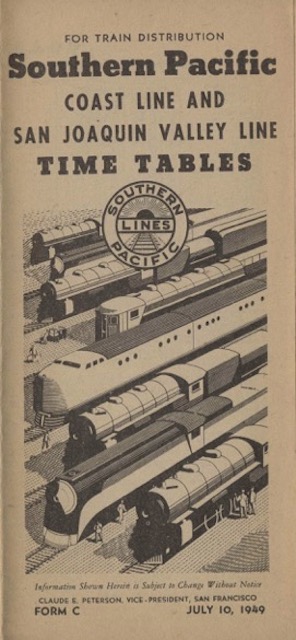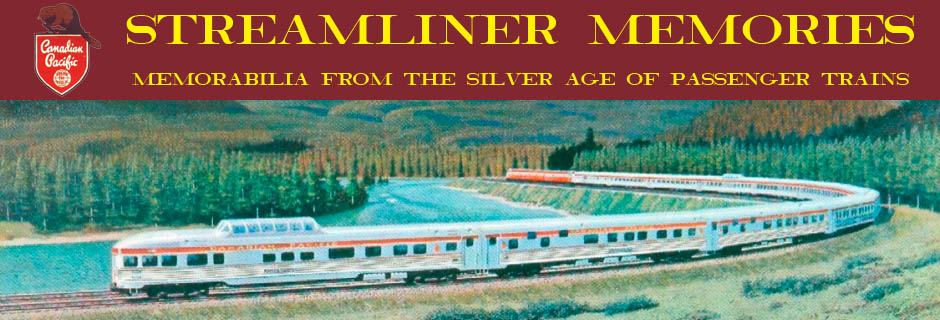Marked “for train distribution,” this folding timetable shows only the Coast and San Joaquin routes. That means it has three panels of coast route schedules (one of which was mostly bus connections), two panels of San Joaquin route schedules, and the cover panel (half of which is dedicated to a description of the various Daylights). The panels, however, are a little smaller than a regular timetable, being about 7-1/2″x8″ instead of 8″x9″.
 Click image to download a 2.3-MB PDF of this timetable.
Click image to download a 2.3-MB PDF of this timetable.
The Daylights half-panel says that the trains feature “very low fares” of “only $7.50 one way” between San Francisco and Los Angeles and $12.00 one way between San Francisco and Portland (plus 15% federal tax). That does sound low, except that in today’s dollars that would be about $100 and $165 (including tax).
Airfares from Los Angeles to San Francisco on major airlines today start at around $40 (including federal tax) and Frontier even has a $20 fare. Of course, the airlines (and Amtrak) today practice yield management, which means only the first seats sell for the lowest prices and the last seats go for much more, while SP in 1949 sold all seats for the same price. However, average airfares are less than half Amtrak’s average charge per passenger mile, which helps explain how planes replaced passenger trains.

The table linked does not discuss fares at all.
As far as I can tell, it talks about REVENUE PER PASSENGER MILE. I do not understand how this connects to fares.
And even if it did, do the airfares in question include the various taxes, fees, and surcharges that are added on to each ticket? What about the subsidies through the construction of airports and ATC?
At the end of the day, it is inherently more economical to move in two dimensions than in three.
I have a tough time seeing how any airline makes money at $40 one way LAX-SFO, let alone $20. Even with a fully loaded airplane having ~150 seats that’s only $6000 gross, and once you add up the cost of wages, fuel, landing slots, aircraft maintenance, debt service etc. etc. I cannot imagine they’re not losing money. I get it that airline seats are a perishable commodity and that it’s better to have someone’s butt in the seat paying something, but every flight in the red has to be compensated for elsewhere, no?
BTW, when I was a boy back in the late 1960s, United used to advertise $13.50 flights on the same route, which works out to $101.74 in today’s dollars. So on some routes at least there has been massive deflation.
A 200-seat airplane costs about $6000/hour to operate, and a 150-seat airplane costs about $4800/hour.
The argument about moving in two dimensions instead of three is not always true. It must be pointed out that airplanes don’t need the maintenance of continuous railroad tracks between the endpoints and that each airport can serve endless potential destinations whereas each set of railroad tracks can only go in a single-directional corridor. It must also be added that airplanes fly as a result of speed and not in addition to it and they also face less drag at high altitudes and avoid rolling resistence once airborne (although rolling resistence has minimal proportional effect on ground vehicles compared to aerodynamic resistence anyway).
Thanks for the explanation John West. Just about the only business I can think of with worse margins that the airlines is the plumbing wholesale business. Certain products are sold on negative margins (e.g. water heaters) and the wholesalers depend on volume based manufacturer rebates to cover their losses and add a little to the bottom line.